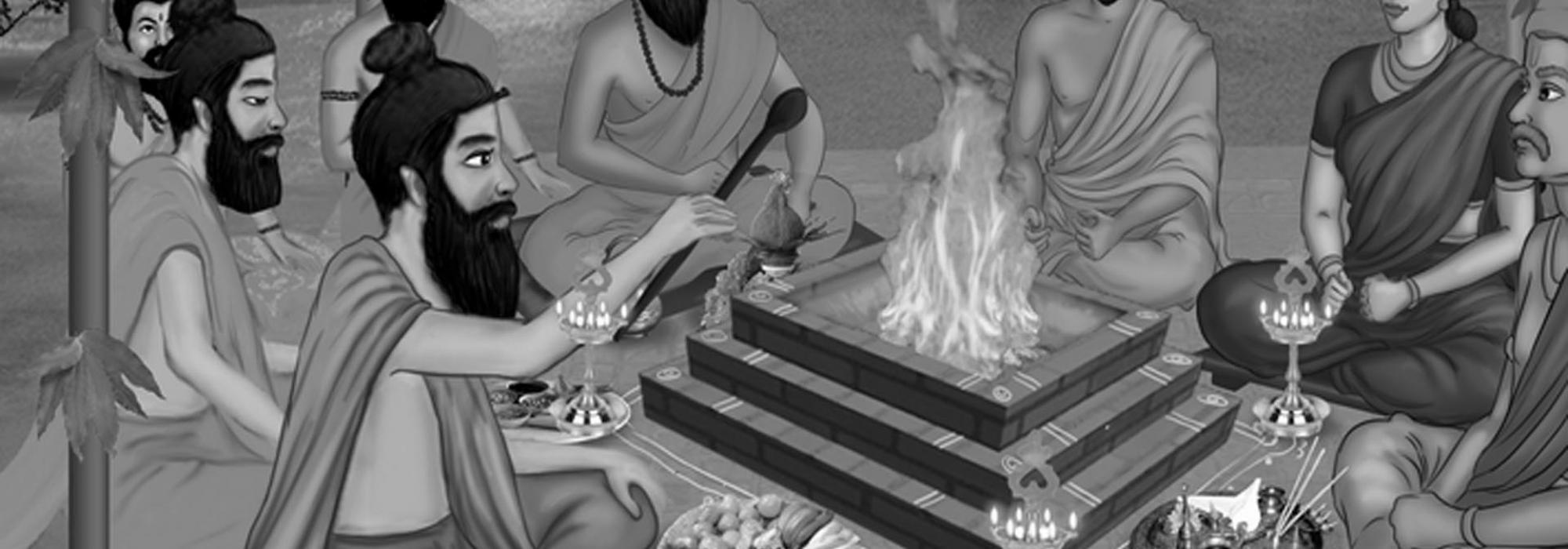பிராம்மண, க்ஷத்ரிய, வைஷ்யர்களிலுள்ள ஆடவர்கள் மாத்திரமே வேதம் பயில தகுதி பெற்றவர்கள் என்று நம் மூதாதையர்கள் பலர் கருதி வந்தனர்.[1] உபநயனம் என்பது வேதம் கற்பதற்கான சடங்காக அமைந்ததால் அனைத்து வர்ணத்தாரினது பெண்களுக்கும், சூத்திரர்களுக்கும் உபநயனம் செய்விக்கப்படவில்லை.[2]
இதற்கு சில விதிவிலக்குகளும் இருந்தன. உதாரணத்துக்கு பாதரீ ஆசாரியர் (Ācārya Bādarī) என்பார்[3], சூத்திரர்கள் உட்பட அனைவருக்குமே வேத யக்ஞங்கள் செய்வதற்கான தகுதி உள்ளது என்கிறார். இதனால் அவர்களுக்கும் உபநயனம் செய்விக்கலாம். இது தவிர, பண்டைய வேத காலத்தில் மூன்று வர்ணங்களே இருந்து வந்தன-முதலாமவர் ஆன்மீகப் பாதையில் ஈடுபட்டு சடங்குகளை வழிநடத்துபவர்கள் (பிராம்மணர்கள்), இரண்டாமவர் ஆட்சிசெய்து போர்புரிபவர்கள் (க்ஷத்திரியர்கள்), மற்றும் மூன்றாமவர் பொது மக்கள் (வைஷ்யர்கள்).[4]
பெண்களுக்கு உபநயனம் நடைபெற்றதா என்பது குறித்தும், அவர்கள் யக்ஞோபவீதம் (பூணூல்) அணிந்தனரா என்பது குறித்தும் சில சுவாரசியமான தகவல்களை ஸ்ம்ருதிகளில் காண்கிறோம். பண்டைய காலத்து பெண்களை இருவகைப் படுத்தினர்-புனித நூல்களைக் கற்கும் பிரம்மவாதினிக்கள் (Brahmavādinīs) மற்றும் நேரடியாக கலியாணம் செய்துகொள்ளும் சத்யோவதுக்கள் (Sadyovadhūs). இவ்விருவருள் பிரம்மவாதினிக்களுக்கு உபநயனம் நடைபெற்று, அவர்கள் அக்னியை வளர்த்து, வேத பாடங்களைப் பயின்று வந்தனர்;பிச்சை எடுத்தே இவர்கள் பிழைக்க வேண்டியிருந்தது, எனினும் இதனை அவர்கள் பொதுவிடங்களில் செய்யாமல், தமது பெற்றோருடன் வசித்துவந்து தமது இல்லத்திலேயே செய்து வந்ததாகத்தெரிய வருகிறது. சத்யோவதுக்களுக்கு விவாக நாள் நெருங்கிவரும்போது உபநயனம் செய்விக்கப்பட்டது, அதன்பின்பே அவர்களுக்கு கல்யாணம் ஆனது.[5]
கல்யாணச் சடங்கின்போது, “இடது தோள்பட்டையில் பூணூல் அணியப்பெற்று நன்கு அலங்கரிக்கப்பட்ட மணப்பெண் இல்லத்திலிருந்து அக்னியை நோக்கி செல்கையில், அவளது கணவன் வேதத்திலிருந்து[6] ஒரு வரியை உச்சரிக்கிறான்.”[7] அதனால் அப்பெண் உபநயனச் சடங்கானதின் அடையாளமாகவே பூணூலை அணிந்திருக்கிறாள் என்று தெரிகிறது.[8]
சமாவர்த்தனம் (samāvartana) எனும் சடங்கு கல்வி பயின்றபின் நடைபெறும். இதிலும் சில குறிப்புக்களைக் காண்கிறோம். களிம்பு பூசிக்கொள்கையில், “இரு கைகளிலும் களிம்பை நன்றாய் தேய்த்துக் கொண்டதும், ஒரு பிராம்மணன் அவனது முகத்தில் பூசிக் கொள்கிறான்; ஒரு க்ஷத்திரியன் அவனது இரு கரங்களிலும், ஒரு வைஷ்யன் தனது வயிற்றிலும், ஒரு பெண் அவளது அந்தரங்க அவயவத்திலும் பூசிக் கொள்கிறார்கள்...”[9], என அஸ்வலாயனர் (Aśvalāyana) கூறுகிறார். வேத பாடங்களைக் கற்ற பெண்கள் அரிதாகவே இருந்திருக்கலாம் எனினும் சுமார் இரண்டாயிரம் ஆண்டுகள் முன்னர் வாழ்ந்துவந்த அஸ்வலாயனர் (Aśvalāyana) அவர்களைப் பற்றி நன்கு அறிந்திருந்தார் என்றே கூறலாம்.
பெண்களை பொருத்தவரையில், அவர்கள் பருவம் எய்தும் முன்பே அவர்களுக்கு சமாவர்த்தனம் நடைபெற்றது.[10] பிரம்மவாதினிக்களுக்கு உபநயனம் அவர்களது கருத்தாக்கத்திலிருந்து எட்டு ஆண்டுகள் ஆனதும் நடைபெற்றது; அதன் பிறகு அவர்கள் வேதம் பயிலத் துவங்கி பூப்பெய்தும் சமயத்தில் வேதத்தில் தேர்ச்சியுற்றனர். கன்னியர்களாயின் முஞ்சையாலான மேகலை (அதாவது, பூணூல்) அணிவிக்கும் வழக்கம் இருந்தது. மேலும் அவர்களை சாவித்திரியை (அதாவது காயத்ரி மந்திரத்தை) உச்சரிக்கச் செய்தனர். அந்நியர்களல்லாமல், அவர்களது தந்தையோ, மாமனோ, சகோதரர்களோ அவர்களுக்கு ஆசானாயினர். பிச்சை எடுப்பது பரிந்துரைக்கப்பட்டிருந்தாலும், இவர்கள் தமது இல்லத்துக்குள்ளேயே பிச்சை எடுத்தனர். மேலும் இவர்கள் மான் தோல் அணியவோ, மரப்பட்டையாலான துணியை அணியவோ, ஜடாமுடி தரித்திருக்கவோ கூடாது.[11]
தனது காலத்தில் இப்பழக்கம் இல்லாதபோதிலும், மனு பண்டைய காலத்து இப்பழக்கவழக்கங்களை அறிந்து வைத்திருந்தார். ஜாதகர்மாவில் துவங்கி உபநயனம் வரையிலான சமஸ்காரங்களைப் பற்றி அவர் கூறுகையில், “இதுபோன்ற சடங்குகள் முற்றிலுமாக பெண்களுக்கும் செய்விக்கப்பட வேண்டும் என்ற போதிலும் மந்திரங்கள் அப்போது உச்சரிக்கப்படுவதில்லை”[12] என்றும் “வேத மந்திரங்களை உச்சரித்து பெண்களுக்கென செய்யப்படும் ஒரே சடங்கு கலியாணம் மாத்திரமே; பெண்களை பொருத்தவரையில் கணவனது தேவைகளை பூர்த்தி செய்வது குரு சேவைக்கு ஒப்பானதாகவும் (குருவுக்கு ஒரு மாணவன் சேவை செய்வதுபோல), வீட்டு வேலைகளைச் செய்வது அக்னியை வணங்குவதற்கு ஒப்பானதாகவும்[13] (ஒரு மாணவன் மாலையில் அக்னிக்கு விறகுக்கட்டைகளை காணிக்கையிடுவதைப் போல) கொள்ளப்பட்டது.” மனு வாழ்ந்த காலத்தில் பெண்களுக்கு உபநயனம் செய்விப்பது புழக்கத்தில் இல்லை, எனினும் அதற்கு முன் இப்பழக்கம் இருந்துவந்ததாகவே தெரிய வருகிறது.[14]
தகுதியுடைய அனைவருமே[15] உபநயனம் செய்துகொண்டனர் என்றும் கூறிவிட முடியாது. க்ஷத்திரியர்களும், வைஷ்யர்களும் பெரும்பாலும் இச்சடங்கை ஓரங்கட்டி வைத்தனர், அல்லது பூணூலை எப்போதும் அணிந்திருக்கும் பழக்கத்தைப் புறந்தள்ளினர். இதனால் யக்ஞோபவீதம் (பூணூல்) அணியும் பழக்கம் பிராம்மணர்களுக்கு மட்டுமே பிரத்யேகமானது என்கிற எண்ணம் அப்போதிருந்தே இருந்துவந்ததாகத் தெரிகிறது.
தொடரும்...
இக்கட்டுரை திரு ஹரி ரவிகுமாரது “Upanayana – A Gentle Introduction” என்கிற ஆங்கில கட்டுரைக்கான மொழிபெயர்ப்பு.
திரு பிரதீப் சக்ரவர்த்தி, ஷதாவதானி டாக்டர் ஆர் கணேஷ், டாக்டர் கோடி ஶ்ரீகிருஷ்ணா, திரு ஷஷி கிரன் பி என், மற்றும் திரு அர்ஜுன் பரத்வாஜ் ஆகியோருக்கு எனது மனமார்ந்த நன்றிகள்.
அடிக்குறிப்புகள்
[1] HDS, pp. 293-99
[2] கௌதமர் முதல் மூன்று வர்ணத்தாரை dvijātis-இரு பிறப்பு கொண்டவர்கள்- என்கிறார். சூத்திரர்களை ekajāti-ஒரு பிறப்பு கொண்டவர்கள்- என்கிறார் (Gautama-dharma-sūtra 10.1 and 51). ஆபஸ்தம்பரோ சூத்திரர்களுக்கும், குற்றவாளிகளுக்கும் உபநயனம் செய்விக்க கூடாது என்று சொல்லுமளவுக்குச் சென்றுவிடுகிறார் (Āpastamba-dharma-sūtra 1.1.1.6). சூத்திரர்கள் ஏளனமாக நடத்தப்பட்டாலும், திறமையுள்ளவர்கள் அதிலும் முன்னுக்கு வந்தார்கள். அவர்களுக்கு வர்ணம் ஒரு தடையாக இல்லை. Kavaṣa Ailūṣa என்கிற சூத்திரன் ரிக்வேத ரிஷியான கதை Aitareya-brāhmaṇa 2.19.1இல் வருகிறது. Mahīdāsa Aitareya என்பவர் Itarā என்கிற சூத்திரப் பெண்ணுக்கு பிள்ளையாகப் பிறக்கிறார். ரிக்வேதத்தின் ஐதரேய சாகையை போதித்தவர் அவர். Chāndogyopaniṣad 4.4இல் சூத்தர பெண்ணுக்கு முறைகேடாகப் பிறந்த Satyakāma Jābāla பற்றின கதை வருகிறது. இவர் நாளடைவில் மாபெரும் ரிஷியாகிறார்.
[3] Jaiminīயின் Pūrva-mīmāṃsā-sūtra 6.1.27யைக்காண்க
[4] மேலும் வேத வாக்கியங்களை சூத்திரர்கள் கற்கத் தடை இருந்ததே அன்றி அதில் இடம்பெறும் கருத்துக்களை அல்ல. உதாரணத்துக்கு, காயத்ரி ஒரு வேத மந்திரம் ஆதலால் ஒரு சூத்திரன் அதனை கற்கத் தடை உள்ளது; மாறாக காயத்ரியின் அதே பொருளில் வரும் புராண மந்திரமான-Yo devaḥ savitāsmākaṃ dhiyo dharmādigocharāḥ. Prerayettasya yadbhargaḥ tadvareṇyamupāsmahe-என்கிற மந்திரம் அவனுக்குக் கற்றுத் தரப்பட்டது
[5] Yattu hārītenoktaṃ dvividhāḥ striyo brahmavādinyaḥ sadyovadhvaśca. Tatra brahmavādinīnāmupanayanamagnīndhanaṃ vedādhyayanaṃ svagṛhe ca bhikṣācaryeti. Sadyovadhūnāṃ tu upasthite vivāhe kathāñcidupanayanamātraṃ kṛtvā vivāhaḥ kāryaḥ. –Smṛticandrikā I, p. 24வில் Hārīta-dharma-sūtra இதனை எடுத்துக் காட்டுகிறார்; Saṃskāra-prakāśa, பக்கம் 402யையும் காண்க
[6] Ṛgveda-saṃhitā 10.85.41
[7] Prāvṛtāṃ yajñopavītinīmamyudānayan japet ‘somo dadadgandharvāyeti’ – Gobhila-gṛhya-sūtra 2.1.19; the commentary says ‘Yajñopavītavatkṛtottarīyām.’ ‘Na tu yajñopavītinīmityanena strīṇāmapi karmoṅgatvena yajñopavītadhāraṇamiti hariśarmoktaṃ yuktaṃ strīṇāṃ yajñopavītadhāraṇānupapatteḥ.’ – Saṃskāra-tattva, பக்கம். 896
[8] மகாபாரதத்தில், அதர்வசிரஸ்ஸிலிருந்து பல மந்திரங்களை ஒரு பிராம்மணன் குந்தி தேவிக்கு சொல்லிக்கொடுத்ததாக வருகிறது. Tatastāmanavadyāṅgīṃ grāhayāmāsa sa dvijaḥ. Mantragrāmaṃ tadā rājannatharvaśirasi śrutam. – Vana-parva 305.20
[9] Anulepanena pāṇī pralipya mukhamagre brāhmaṇo anulimpet. Bāhū rājanyaḥ. Udaraṃ vaiśyaḥ. Upasthaṃ strī. Ūrū saraṇa jīvanaḥ. – Āśvalāyana-gṛhya-sūtra 3.8.11
[10] Prāgrajasaḥ samāvartanam. Iti hārītokstyā – Saṃskāra-prakāśa, பக்கம் 404யில் ஹரிதா இதனை எடுத்துக்காட்டுகிறார்
[11] Yamopi. Purākalpe kumārīṇāṃ mauñjībandhanamiṣyate. Adhyāpanaṃ ca vedānāṃ sāvitrīvācanaṃ tathā. Pitā pitṛvyo bhrātā vā naināmadhyāpayetparaḥ. Svagṛhe caiva kanyāyā bhaikṣacaryā vidhīyate. Varjayedajinaṃ cīraṃ jaṭādhāraṇameva ca. – Saṃskāra-prakāśa, pp. 402-3வில் Yama இதனை எடுத்துக்காட்டுகிறார்
[12] Amantrikā tu kāryeyaṃ strīṇām āvṛdaśeṣataḥ. Saṃskārārthaṃ śarīrasya yathākālaṃ yathākramam. – Manu-smṛti 2.66
[13] Vaivāhiko vidhiḥ strīṇāṃ saṃskāro vaidikaḥ smṛtaḥ. Patisevā gurau vāso gṛhārtho’gniparikriyā. – Manu-smṛti 2.67
[14] HDS, பக்கம் 295
[15] க்ஷத்திரியர்கள், வைஷ்யர்கள் தவிர anuloma jātis (e.g. rathakāra, ambaṣṭha &c.) போன்ற பிற வகுப்பினரும் இச்சடங்கை செய்ய தகுதி உள்ளது (Manu-smṛti 10.41யைக் காண்க)
















































